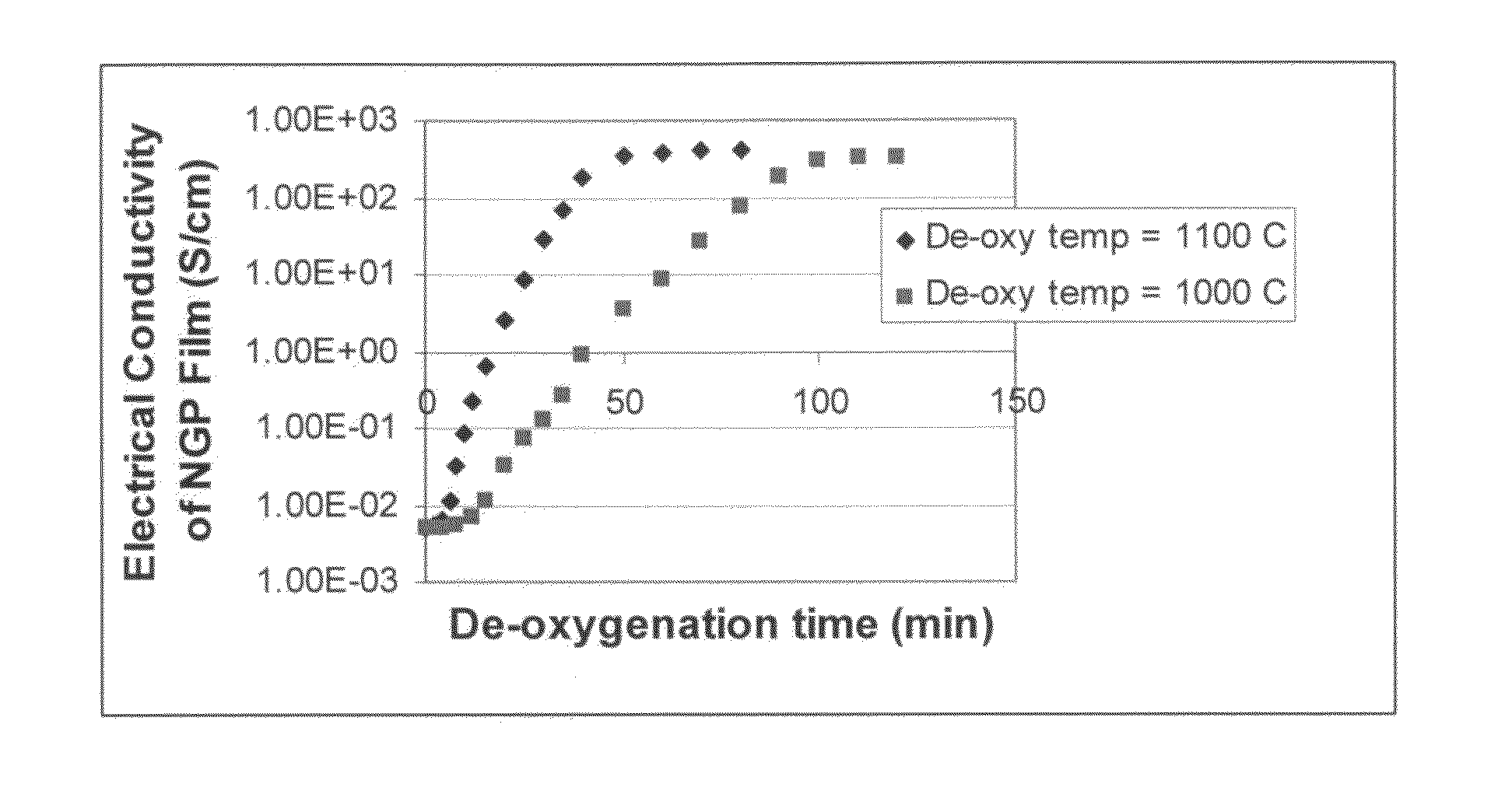Process for producing dispersible nano graphene platelets from oxidized graphite
a technology of oxidized graphite and nano graphene, which is applied in the direction of single-layer graphene, electrolysis components, chemistry apparatus and processes, etc., can solve the problems of tedious process, inability to disperse go platelets in water or other solvents, and inability to produce nano graphene platelets. irreversible agglomeration,
- Summary
- Abstract
- Description
- Claims
- Application Information
AI Technical Summary
Benefits of technology
Problems solved by technology
Method used
Image
Examples
example 1
NGPs from Carbon / Graphite Fibers
[0152]Continuous graphite fiber yams (Magnamite from Hercules) were cut into segments of 5 mm long and then ball-milled for 24 hours. Approximately 20 grams of these milled fibers were immersed in a mixture of 2 L of formic acid and 0.1 L of hydrogen peroxide at 45° C. for 48 hours. Following the chemical oxidation intercalation treatment, the resulting intercalated fibers were washed with water and dried. The resulting product is a formic acid-intercalated graphite fiber material containing graphite oxide crystallites.
[0153]Subsequently, approximately ½ of the intercalated or oxidized fiber sample was transferred to a furnace pre-set at a temperature of 600° C. for 30 seconds. The compound was found to induce extremely rapid and high expansions of graphite crystallites. The as-exfoliated graphite fiber is designated as Sample-1a. Approximately half of Sample 1-a material was subjected to de-oxygenation at 1,100° C. for 20 minutes in a nitrogen atmosp...
example 2
NGPs from Sulfuric Acid Intercalation and Exfoliation / De-Oxygenation of MCMBs
[0156]MCMB 2528 microbeads were supplied by Alumina Trading, which is the U.S. distributor for the supplier, Osaka Gas Chemical Company of Japan. This material has a density of about 2.24 g / cm3; a particle size maximum for at least 95% by weight of the particles of 37 microns; median size of about 22.5 microns and an inter-planar distance of about 0.336 nm. MCMB 2528 (10 grams) were intercalated with an acid solution (sulfuric acid, nitric acid, and potassium permanganate at a ratio of 4:1:0.05) for 24 hours. Upon completion of the reaction, the mixture was poured into deionized water and filtered. The intercalated MCMBs were repeatedly washed in a 5% solution of HCl to remove most of the sulphate ions. The sample was then washed repeatedly with deionized water until the pH of the filtrate was neutral. The slurry was spray-dried and stored in a vacuum oven at 60° C. for 24 hours. The dried powder sample was...
example 3
Oxidation, Exfoliation, and De-Oxygenation of Natural Graphite
[0157]Graphite oxide was prepared by oxidation of graphite flakes with sulfuric acid, sodium nitrate, and potassium permanganate at a ratio of 4:1:0.05 at 30° C. for 24 hours, according to the method of Hummers [U.S. Pat. No. 2,798,878, Jul. 9, 1957]. Upon completion of the reaction, the mixture was poured into deionized water and filtered. The sample was then washed with 5% HCl solution to remove most of the sulfate ions and residual salt and then repeatedly rinsed with deionized water until the pH of the filtrate was approximately 7. The intent was to remove all sulfuric and nitric acid residue out of graphite interstices. The slurry was spray-dried and stored in a vacuum oven at 60° C. for 24 hours. The interlayer spacing of the resulting laminar graphite oxide was determined by the Debey-Scherrer X-ray technique to be approximately 0.73 nm (7.3 Å), indicating that graphite has been converted into graphite oxide.
[0158]...
PUM
| Property | Measurement | Unit |
|---|---|---|
| temperature | aaaaa | aaaaa |
| temperature | aaaaa | aaaaa |
| temperature | aaaaa | aaaaa |
Abstract
Description
Claims
Application Information
 Login to View More
Login to View More - R&D
- Intellectual Property
- Life Sciences
- Materials
- Tech Scout
- Unparalleled Data Quality
- Higher Quality Content
- 60% Fewer Hallucinations
Browse by: Latest US Patents, China's latest patents, Technical Efficacy Thesaurus, Application Domain, Technology Topic, Popular Technical Reports.
© 2025 PatSnap. All rights reserved.Legal|Privacy policy|Modern Slavery Act Transparency Statement|Sitemap|About US| Contact US: help@patsnap.com



